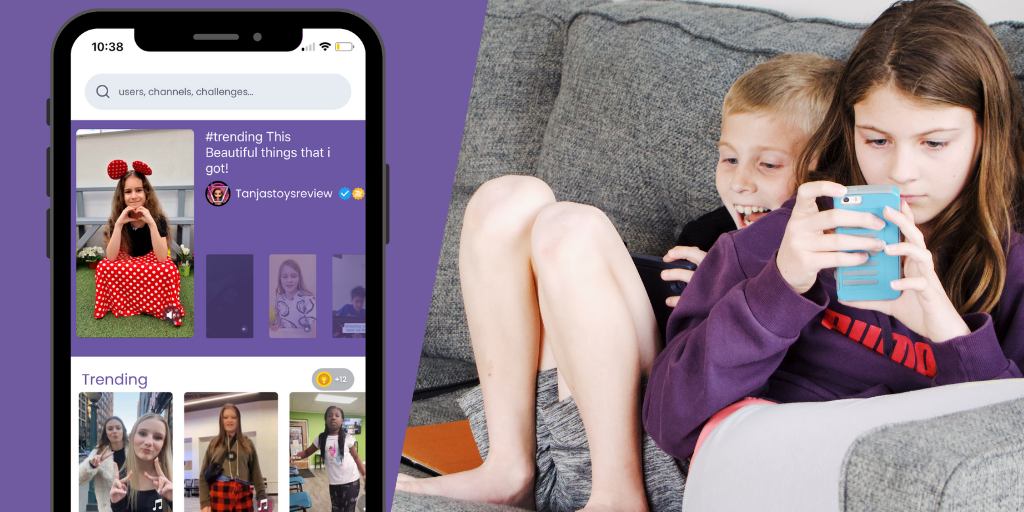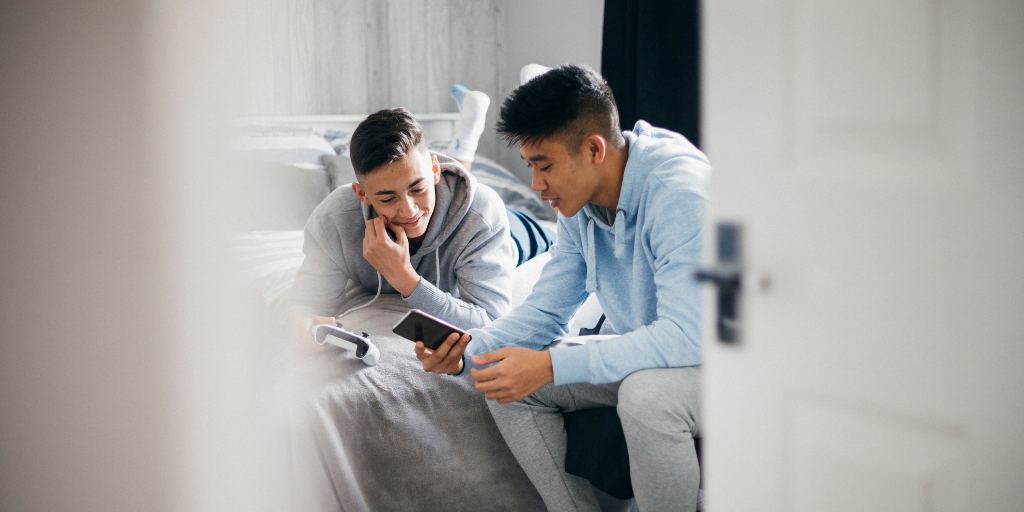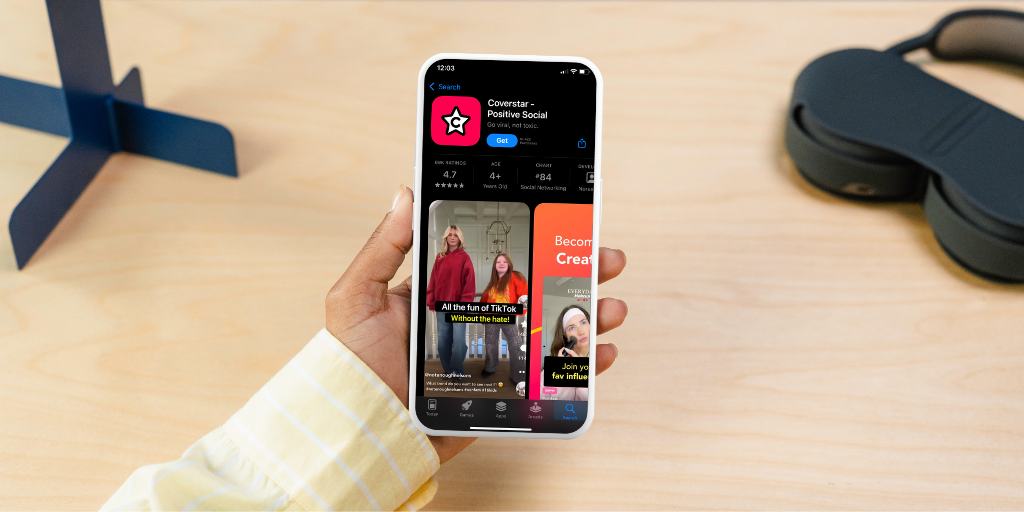
Teens are hardwired to have romance on the brain, so it’s no surprise that romance books are very popular with this age group. To help guide your romance-loving kiddo, I surveyed the teens in my life about what’s on their bookshelves. In order to find something for everyone, I looked for books that cover a wide range of subgenres, from mystery to romantacy.
And because YA can vary widely in explicit content (also known as smut), I’ve also included a spice scale so you know what your teen is getting into.
Here it is: our roundup of the best romance books for teens.
| Rating | Spice level |
| 🚫 | Squeaky clean |
| 🌶️ | Just a dash |
| 🌶️🌶️ | Mild-to-medium |
| 🌶️🌶️🌶️ | Steamy, but not explicit |
| 🌶️🌶️🌶️🌶️ | Explicit |
| 🌶️🌶️🌶️🌶️🌶️ | Bordering on erotic |

For 15-year-old Belly, this is the summer that everything changes when she finds herself in a love triangle with two brothers she’s known her whole life. This light, coming-of-age romance is the first book in a trilogy and the basis for a popular TV series, so if your teen likes it, there’s plenty of material to binge.
Best for: 13+
Spice level: 🌶️🌶️
While teen characters frequently smooch (and talk a lot about romance and dating), it’s not explicit, and they don’t go further than heavy makeout sessions.
There’s some swearing, name-calling (including “slutty”), and use of “gay” as an insult. The teens smoke cigarettes and drink at parties (although they pointedly don’t drive drunk). There isn’t much violence, but the boys do get into a fistfight at one point.

When 16-year-old Avery inherits $46 billion from an oil tycoon she’s never heard of, there’s a huge catch: she has to leave her home in Connecticut and live in the deceased man’s Texas estate for a year. While mystery and puzzle-solving are the primary focus of the book, romance readers will love the delicious subplot as Avery finds herself entangled in a love triangle with the dead tycoon’s grandsons.
Best for: 13+
Spice level: 🌶️
Romantic tension abounds, but it never goes beyond kissing, and nothing is explicit.
There are a couple of instances of teenage drinking, and during one episode, a teen engages in dangerous behavior. There’s a non-life-threatening shooting, and one adult is in an abusive relationship.

After her parents die, 17-year-old Grace is forced to attend a mysterious boarding school filled with supernatural creatures. She quickly becomes entangled in a web of dangerous secrets and forbidden love. Fans of Twilight will love this book.
Best for: 14+
Spice level: 🌶️🌶️🌶️
While most of the action takes place behind closed doors, an undercurrent of sexual tension runs through the book. There’s heavy petting — including steamy vampire bites — and plenty of talk about desires. It’s not exactly explicit, but it’ll definitely make you blush.
This book is heavy on both swearing and violence, although the fighting is largely between supernatural creatures.

Seventeen-year-old Liz has always believed she's too black, too poor, and too awkward to shine in her small, rich, prom-obsessed Midwestern town. The only thing that makes it halfway bearable is the new girl in school. But a twist finds the girls both running for prom queen, and Liz falling hard for the competition.
Best for: 13+
Spice level: 🚫
The romance is very subtle and focuses more on an emotional rather than physical connection. There’s hand-holding, slow dancing, and a sweet first-kiss moment, but that’s it.
The protagonist deals with bullying, homophobia, racism, and the past loss of a parent. There are a handful of instances of swearing.

Seventeen-year-old Lady Alexandra’s mother is determined to marry her off to a safe, respectable young man befitting her place in aristocratic society. Instead, she becomes embroiled in adventure, espionage, and a budding clandestine romance with the brooding son of an earl.
Best for: 12+
Spice level: 🚫
While the stolen kisses would have been scandalous in Regency London, they’ll strike the modern reader as quite tame.
No content warnings here. Just good, clean romance.

Seventeen-year-old Scarlett has never left the tiny island where she lives with her powerful and cruel father. Her chance to escape finally presents itself in the form of a long-dreamt-of invitation to Caraval — the faraway, once-a-year performance where the audience participates in the show. Although Caraval is said to be only a performance, the stakes are real in this game of love, heartbreak, and magic.
Best for: 13+
Spice level: 🌶️🌶️
There are passionate kissing scenes, romantic tension, and innuendo. While there is the mild implication of sex, nothing explicit happens on the page.
There is mild drinking, a fair bit of violence and death, and a lot of talk of suicide. The protagonist's father is abusive and manipulative, and at one point, he hits his daughter.
Want a better way to stay informed about your child’s interests? BrightCanary gives parents insights into what their children type across all the apps they use, including what they’re sending to their friends on Instagram direct messages and texts. Download the app now and start your free trial.

With rising concern over the safety of TikTok for kids, a slate of alternative video-sharing apps are rising in popularity. Enter Zigazoo, a popular social media site for kids with major celebrity backing. But is Zigazoo safe for kids?
Read on to find out what Zigazoo does to keep kids safe, concerns you need to be aware of, and how to help your child use the app safely.
Zigazoo is a TikTok-style social media platform designed specifically for kids. The company was founded by two former school teachers with the goal of creating a safe and positive online community for kids.
On Zigazoo, kids can post short videos of themselves completing kid-appropriate TikTok-style challenges. Users sign up using a Google, Facebook, or Apple account, and kids must have parental consent to use the app.
Challenges are created by kid creators, celebrities, and kid-focused channels like zoos and children’s museums. Users can choose whether to make videos public or private. The company says all videos must be approved by a human moderator, as opposed to automatic filters.
Some examples of challenges include:
Zigazoo has parental controls, but they function a bit differently than other apps by putting parents in the driver’s seat. Parents create a login tied to their own Google, Facebook, or Apple account, and they can log in directly to view their child’s activity and help manage their account.
One of the big selling points for Zigazoo are the human moderators that check each video before it can be posted. According to the company’s website, here are some of the things their moderators check for:
While Zigazoo is generally safe for kids, there are a couple of things parents need to be aware of.
It’s not possible to set an entire account as private. Instead, users must decide whether to make each individual video public or private. That gives parents less control over their child’s account and makes it easy for kids to accidentally post something as public.
Kids can use real money to purchase Zigabucks and use them to customize their profile, send gifts, and unlock creative features like stickers and animations. Parental approval is technically required, but the only verification is a fairly simple math problem that the average 9-year-old can solve.
Because it’s designed specifically for kids, Zigazoo has more features that make it safe for kids. Here’s how Zigazoo stacks up against other platforms:
| Safety Feature | Zigazoo | TikTok | |
| Human moderation | Yes | Primarily AI and filters | Primarily AI and filters |
| Direct Messaging | No | Yes | Yes |
| Parental Consent Required | Yes | No | Not for account creation |
| KidSafe COPPA Certified | Yes | No | No |
| Age Verification | Robust | Easy to bypass | Easy to bypass |
| Parental Controls | Yes, parents have full access to child's account | Yes, through TikTok Family Sharing | Yes, through Instagram Teen Accounts |
Here are some ways to help make your child’s Zigazoo experience even safer:
Compared to other social media platforms like TikTok, Zigazoo is far safer for kids. However, parents need to be aware of risks like a lack of global privacy settings and in-app purchases. Parents should discuss the dangers of social media with their child and stay involved in monitoring their use.
BrightCanary helps parents monitor their children’s activity on the apps they use the most, including what they type on Zigazoo and TikTok. Download today to get started for free.

A BrightCanary parent noticed that her 14-year-old daughter was getting messages from an adult. Fortunately, she was able to get more details about the situation and take action. No parent wants to see signs of grooming, but in today’s digital age, stories like these are all too common.
As many as 20% of children were contacted by an online predator in the last year. Online grooming can impact any child, but there are things parents can do to take action. Here’s what you need to know about this serious issue.
Grooming is the process a predator uses to draw a child in by gaining their trust in order to sexually abuse them and maintain secrecy. It may take months or even years for a predator to break through a child’s defenses and increase the likelihood they’ll accept physical contact.
Grooming happens both in person and, increasingly, in digital spaces.
While grooming can take many different forms, it often follows a similar pattern. Knowing the typical trajectory may help parents identify it early so they can put a stop to it.
Predators test the waters by setting traps. It’s easy for a child to fall prey to one without meaning to. For example, 46% of children give personal information away about themselves online. This helps predators identify victims, build trust, and establish a relationship around shared interests.
A predator may comment on a social media post or send a message to a child they’ve targeted. This is easier than you might think: if your child has a public TikTok account, anyone can send them a direct message request.
Predators typically lie about their age, often adopting a persona that’s just slightly older than the potential victim. Conversations tend to start innocently. The predator may offer something they sense the child craves, such as praise, appreciation, or a listening ear.
After establishing trust, predators ask increasingly private questions. They inquire about the child’s relationships with friends, parents, and trusted adults. The predator uses this information to isolate the child from their support system.
As the conversation gets more personal, predators may move the conversation to a more secretive app, such as Snapchat or WhatsApp, in order to test the child’s boundaries and willingness to keep the relationship a secret.
Once the predator has strengthened the bond to the point where the child protects the predator instead of themselves, they begin to slowly sexualize the interactions. Initial discussions of sexual activity help prime the child. The predator may share nude or partially nude images of themselves or other children before asking for sexually explicit images or videos of the victim.
Here the warning signs of online grooming to keep an eye out for:
First, stay calm and gather information. Document the warning signs you’ve noticed. Look at their social media feeds and text messages to see what you can find out. If you use a parental monitoring app like BrightCanary, you can use it to review messages your child has sent and received on TikTok, Instagram, and text messages — including deleted texts.
Then, talk to your child. Have a calm, non-judgmental conversation with your child about their online activities and your concerns. Make it clear that they’re not in trouble, and your goal is to protect them.
Make a plan to report the grooming. Contact local authorities and the online platform(s) where the grooming occurred to report the issue.
Finally, get professional help for your child. A child psychologist or counselor can help your child through the experience and provide you with ideas to further support them at home.
Here are steps you can take now to make it less likely your child will be a victim of online grooming:
Online predators are an increasing concern in today’s digital age. Parents need to educate themselves and their child about how to spot the warning signs of grooming and what to do if a predator makes contact. Educating children about the risks, teaching strong boundaries, and taking steps to monitor children’s online activity are important preventative measures.

Tweens and teens using coded language to subvert adults is nothing new. Experts say slang has likely existed for as long as human language. But the advent of the internet and the rise of social media has turbo-charged the cycle.
With the BrightCanary Keyboard, you can see everything your child types online. But when they use coded or indirect language, it can be hard to know when they’re searching for things you’d rather they didn’t. In this article, we’ll look at terms that could mean your child is looking up inappropriate content.
There’s no one reason why kids use coded language when they search online. It could signal they’re up to trouble but could just as easily be innocent.
Here are a few reasons your child might be using indirect search terms:
Here’s some terms teens might type into Reddit or Google incognito mode.
For a comprehensive list of teen slang parents need to know, check out these BrightCanary guides:
If you spot one of these terms in your child’s search history or with the BrightCanary Keyboard, here are some tips on how to respond:
Your child’s internet searches are a window into their world, but tweens and teens often use slang and other coded language to fly under the radar of school filters and adult eyes. It’s important to familiarize yourself with terms that could signal an interest in inappropriate or harmful material so you can intervene and support your child.
BrightCanary helps you monitor your child’s internet searches, providing you with real-time information so you can help keep them safe. Download today to get started for free.

Cyberbullying has been around as long as the internet, but social media platforms have made it easier, faster, and more public than ever. Today, tweens and teens may be exposed to cyberbullying through DMs, group chats, viral memes, and even disappearing messages.
As a parent, it’s important to understand how cyberbullying happens on social media, what signs to look for, and how to step in if your child is affected.
Social media cyberbullying refers to harassing, threatening, or humiliating behavior that takes place on platforms like Instagram, Snapchat, TikTok, and others. This can include hurtful comments, messages, or posts that are intended to embarrass, exclude, or intentionally harm someone.
Nearly 60% of teens experience online abuse, and 25% say they’ve received explicit images they didn’t ask for. Social media’s constant connectivity and viral nature makes it especially difficult for kids to escape or recover from bullies.
Here are some of the most common ways your child might experience cyberbullying on social media.
Forget traditional text messages — most tweens and teens communicate with their peers primarily through direct messages (DMs) on social media. That may include sending harassing or threatening DMs intended to bully the recipient.
Because DMs aren’t visible to others, this form of bullying generally goes unnoticed by adults.
If you have a monitoring service like BrightCanary, you’ll be able to monitor what your child types on their iPhone or iPad — including DMs on popular social platforms and every app they use.
If you’ve spent any time on social media, you know how easily a comment thread can turn into a raging dumpster fire. Cyberbullies often make nasty comments on their target’s social media posts, which can quickly snowball as others join in.
Doxxing involves publishing a person’s private information online without their consent. It originated with ‘90s hacker culture, but has since taken its place on the mainstream internet, particularly with the rise of social media.
The information revealed in doxxing can vary from embarrassing to dangerous, and it’s often accompanied by threats or inciting others to harass the targeted person.
We all laugh at a good meme now and again — but they can be a tool for cyberbullies, too. Sometimes, bullies take photos or videos of their targets and turn them into cruel or embarrassing memes, spreading them across social media.
Due to the viral nature of memes, the damage inflicted on your child can be long-lasting.
Part of the internet’s appeal for bullies is the ability to remain anonymous. A bully may create a fake account or screen name — sometimes referred to as a sockpuppet — in order to fly under the radar.
A teen may use a fake account to strike up an online relationship with a peer, then spread the personal information gained in their conversations.
If your child shares intimate photos or videos, even in a trusted relationship, there’s a risk that material could be shared without their consent. This can happen if the relationship goes sour or the material finds its way into someone else’s hands.
7. Snapchat and disappearing messages
Apps like Snapchat make cyberbullying harder to detect. Because Snaps disappear after viewing, kids may not report what they saw — especially if they fear no one will believe them. Bullies may also screenshot a response and spread it to escalate the bullying.
Kids don’t always tell parents when they’re being bullied online. Here are some signs that may indicate something is wrong:
If you notice any of these, check in with your child using open-ended questions and offer support without judgment.
Here are some actions you can take if your child is the victim of cyberbullying.
Blocking the bully is a quick way to end the behavior and give your child a break. Social media platforms also have mechanisms for reporting cyberbullying, which can lead to a user being temporarily or permanently banned.
Take screenshots of the bullying, especially before it disappears (as with Snaps). Save dates, usernames, and messages in case you need to report the behavior to the school, platform, or authorities.
Listening to your child with empathy and without judgment or blame is one of the most important things you can do to support them when they’re being cyberbullied.
Cyberbullying can range from hurtful to dangerous. Sometimes, blocking a bully and letting your child cry on your shoulder isn’t enough. If you feel the situation is getting out of hand, it may be time to take additional steps, like contacting the authorities, alerting the school, or seeking counseling for your child.
For additional tips on what to do if your child is being cyberbullied, including tips on documenting the situation, conversation starters, and what to do if your child witnesses cyberbullying, check out our comprehensive guide.
BrightCanary helps you monitor your child’s online activity across social media and messaging platforms. You’ll get real-time summaries and alerts about potential issues, including signs of cyberbullying — so you can step in when it matters most.
By staying informed and involved, you can help your child navigate social media with confidence and safety.
Many teens and tweens face instances of cyberbullying. Social media presents unique avenues for cyberbullying that parents should know and be prepared to help their children address.

TikTok is mega popular with kids, but it’s also super risky. We looked at five apps to see if they are safe versions of TikTok for kids. We based our decision on how actively the apps moderate content and prevent concerning material for minors, how robust the parental controls are, and whether kids can easily get around age verification measures.
| TikTok Alternatives for Kids | Our Verdict |
| Coverstar | 👍 Give it a try! |
| Zigazoo | 👍 Give it a try! |
| Marco Polo | 👍 Give it a try! |
| TikTok Under 13 Experience | 👎 Steer clear! |
| Triller | 👎 Steer clear! |
Coverstar is a short-form video social media app that promises a safe, supportive alternative to TikTok for tweens and teens.
👍 Give it a try!
Concerns about a lack of parental controls are eased by the fact that the app is inherently quite safe. And although there’s no age verification, the parental consent requirement is robust.
Zigazoo is a TikTok-style social media platform centered around age-appropriate video challenges.
👍 Give it a try!
We love Zigazoo’s focus on positivity and thoughtful approach to user safety. Their strong age verification process, required parental consent, and human moderation helps keep your child safe on the app.
Did you know? BrightCanary monitors your child’s activity across all the apps they use, including the apps on this list. You’ll get insights into what they type, their emotional well-being, summaries of their activity, and more.
Kids under 13 who sign up for TikTok will be automatically directed to the Under 13 Experience, which is designed and curated with younger users in mind.
👎 Steer clear!
We like the Common Sense-curated feed, private accounts, and the fact that users can’t post videos. But these pros are overshadowed by some pretty big cons. Chief among them is the fact that, once parents have okayed downloading the Under 13 Experience, kids can easily create a second account and bypass TikTok’s flimsy age verification. Plus, we really don’t trust TikTok’s algorithm.
Triller is a video-based social media platform for people over 13 that lets users browse, create, and post videos.
👎 Steer clear!
We’re not sure how Triller seems to show up on every list of safe TikTok alternatives for kids. It has red flags all over it. This app isn’t even suitable for young teens.
Marco is a video chat social media app, with a turn-taking format and the ability to send messages to groups of up to 200 people. Users have to be 13 to use it.
👍 Give it a try!
While it doesn’t mirror the TikTok experience to the same degree some of the other apps do, Marco Polo is a good option with strong privacy settings. If your teen wants to share videos, but you only want them to be able to chat with people they know, give Marco Polo a try.
We reviewed five TikTok alternatives to see if they’re safe for kids. Coverstar, Zigazoo, and Marco Polo all get the thumbs up from us, while Triller and TikTok Under 13 Experience get a thumbs down.
To keep an eye on what your child is doing online, try BrightCanary. The app uses advanced technology to help you monitor your child’s activity on the apps they use the most. Download today to get started for free.

The moment your child discovers incognito mode, can be dread-inducing because it makes it harder to keep an eye on what they’re up to online. If you’re wondering how to monitor incognito browsing, you might be concerned about risks such as peer pressure and seeking out inappropriate material.
Fortunately, there are solutions, including specialized child safety tools designed to monitor your child’s internet searches — even in incognito mode.
Also known as private browsing, incognito browsing is a feature in most web browsers that allows users to browse without any records of visited websites or online activity.
Before we get into how to monitor incognito browsing, it’s helpful to first understand how it works. Here are the basics:
Although the functionality of incognito mode is basically the same across all major browsers, it might be called different names:
Incognito mode keeps a number of things private. It blocks local storage of search history, cookies and site data, and information entered into forms. Additionally, others who use the same device won’t see activity from incognito mode.
“Private” doesn’t always mean private in incognito browsing. Here are the limitations:
There are many reasons why kids might use incognito mode, ranging from innocent to worrisome.
While this sort of curiosity, exploration, and desire for privacy is developmentally normal behavior, exercising it on the internet can expose your child to risks. It could lead to viewing inappropriate material and — depending on where they turn for answers — open them up to unsafe contact with strangers.
That’s why it’s important to be proactive in monitoring your child online, even when they turn to incognito browsing.
There are two ways to monitor incognito browsing for your child: disabling it or using a third-party monitoring app like BrightCanary designed to work around private browsing.
When you set up a child account on Google Family Link, incognito mode is automatically disabled for Chrome, meaning your child can’t browse the internet outside of your watchful eye. However, they can still use private browsing in Safari and other browsers.
The BrightCanary Keyboard gives you access to your child’s searches and the websites they visit on their iPhone and iPad — even in incognito mode.
The app’s advanced technology scans everything they type and provides you with real-time AI-powered summaries, along with alerts when your child comes across harmful content. BrightCanary is only available for iPhones or iPads at this time, so desktop monitoring isn’t yet available.
When you disable incognito browsing, you still have to check your child’s internet history to see what they’re up to online. That’s a lot of work. With BrightCanary, you have the peace of mind of knowing when they come across any red flags.
Incognito browsers make it difficult to monitor what your child does on the internet, which can expose them to various risks.
If you’re looking to monitor your child’s incognito browsing, you can either disable it altogether or use an app like BrightCanary, which monitors everything your child types across all the apps they use, even in incognito mode. Download today to get started for free.

As parents, we diligently safeguard our children from real-world dangers, but we can’t overlook the potential threats lurking in the digital realm. It’s important to empower your children with the knowledge and skills to keep themselves safe in digital spaces. Luckily, there are effective strategies to teach kids of any age about protecting themselves from online predators.
Online predatory behavior encompasses a range of activities, including sexual abuse, grooming minors, sextortion, commercial sexual exploitation, nonconsensual sexting, revenge porn, and the production of self-generated child sexual abuse images.
Predators have been known to target kids in just about any corner of the internet, including direct messages, comments sections of YouTube and TikTok, and video game message boards. Even seemingly innocuous things like Fitbit community boards can be a route for predators.
Statistics show that as many as 20% of children were contacted or solicited by an online predator in the last year. While that’s a scary number, it’s crucial to understand that just because a predator contacts your child doesn’t mean their exploitation attempts will be successful. Teaching your child how to spot and respond to predatory behavior can effectively shut down any attempts.
It’s never too early to start teaching your children skills that will help protect them from predators on social media and online. Here are some tips for how to talk to your kids at any age:
All of the above, plus:
All of the above, plus:
All of the above, plus:
In addition to empowering your child to keep themselves safe from online predators, here are some further steps you can take:
Online predators might exploit children, ranging from emotional manipulation to more severe forms of abuse.
The anonymity of the internet allows strangers to deceive children, with adults sometimes posing as peers. Even casual conversations can lead tweens to inadvertently share personal details, opening doors to identity theft or cyberstalking.
Online interactions can be a source of cyberbullying, exposing tweens to inappropriate or harmful content, causing emotional distress. Moreover, virtual interactions can turn into real-world encounters, bringing about direct physical threats.
Stranger danger online can manifest in many ways, one of which is catfishing. For instance, a tween might be approached on a social media platform by someone claiming to be another child their age, sharing common interests. Over time, the "friend" might ask for personal details, photos, or even a meet-up. However, this "child" could actually be an adult with malicious intentions, hiding behind a fabricated profile. This deceptive act, aiming to exploit the unsuspecting tween emotionally, financially, or physically, underscores the importance of being cautious and discerning with online relationships.
Predatory online behavior refers to actions taken by individuals, typically adults, who use the internet to exploit others, especially children and tweens. This behavior can include grooming minors, where the predator builds a seemingly trustworthy relationship with the child to manipulate or exploit them later. It might involve requests for personal information, inappropriate conversations, or attempts to arrange face-to-face meetings. Often, the predator disguises their true identity and intentions, presenting a false persona to gain the child's trust. Parents should be vigilant and educate their children about these dangers, ensuring they know how to recognize and avoid such threats online.
There are an estimated 500,000 online predators active each day, according to the Beau Biden Foundation.
To avoid online predators, it's essential to be cautious and vigilant when interacting online. It's a good practice to keep devices in communal areas, regularly review friend lists and messages, and use parental control tools.
Parents should educate their tweens about the importance of not sharing personal information, such as their full name, address, school, or phone number. They should also emphasize the dangers of speaking to strangers online and discourage forming friendships with unknown individuals.
Tweens should be encouraged to report any suspicious interactions or uncomfortable conversations immediately, and parents should maintain open communication, ensuring their child feels safe discussing their online experiences without fear of punishment.
By teaching children skills to keep themselves safe from an early age, in addition to monitoring their internet activity, parents can help protect their children from the dangers of online predators.

Between inadequate filters on school computers and tech-savvy teens who can easily find digital loopholes, many kids spend their class time doing anything but schoolwork. We chatted with some teachers to find out how kids bypass school filters and tips for helping your teen stay focused during class.
Many school districts use software to manage and restrict access to certain types of online content on school computers and networks. They’re intended to prevent kids from accessing inappropriate content at school, but they don’t always work.
We reached out to Dr. Genét Simone, a Career and Technical Education teacher with Seattle Public Schools, and author of Teaching in the Dark. She consulted with her colleagues and reported on the ways teens bypass school filters:
If you have reason to believe your child is getting around web restrictions at school, here are some steps you can take to address the issue:
There are many reasons a teen might choose to bypass a school filter. It could be straight defiance, but they could also be bored because they’re not being challenged in class, or they feel overwhelmed and turn to an online game for a brain break.
Ask your child why they’re doing it and what benefit they get from the behavior. Then you can create a game plan that addresses the root cause of the behavior.
Teachers were split on this issue. While some urged parents to take a child’s phone away if they’re using it to get around filters, others felt this wasn’t enough.
Simone wants parents to realize that if a child is addicted to their phone, as soon as they have it back, they’ll revert to the unwanted behavior. She urges that “kids need intervention — they need practice with swapping their phone for another activity.”
Here are her suggestions if you suspect phone addiction is a factor:
Be clear with your teen that schoolwork is the priority when they’re in class. Ask them to show you their work each day. Many districts also have systems set up where parents can easily track their child’s assignments online.
Simone stressed that the first line of defense for parents should be to work directly with their child. But she also cited several reasons for parents to reach out to the school:
Simone’s colleagues also suggested using specialized apps to watch what your child is up to on their devices during class.
BrightCanary is designed to do just that by using real-time AI monitoring and summaries to help you keep an eye on your child’s activity when they use their iPhones or iPads, at school or at home.
School filters and device policies are often inadequate and allow kids to easily bypass them during class. In addition, teens are tech-savvy and creative at finding workarounds. Parents should keep an eye on their child’s online activity to ensure they’re on track during class, set clear expectations for device use, and work with the school if the issue can’t be solved at home.
BrightCanary helps parents monitor what their child is really doing online, both in school and out. Download today to get started for free.

If your kids love the cute animal videos and lip sync battles on TikTok, but you don’t love the inappropriate content and exposure to strangers, Coverstar presents an interesting alternative.
The app bills itself as “The Safe TikTok Alternative” and promises a kid-friendly experience. But is Coverstar safe for kids or not? We investigated how it works, what parental controls are offered, and how it stacks up against TikTok.
Coverstar is a short-form video social media app designed for tweens and teens. It promises a safe and supportive environment for kids in the following ways:
Similar to TikTok, Coverstar lets users create, share, and watch short videos with the option of adding music, sound effects, voice-overs, and visual effects like filters and masks. Users can create and participate in challenges, and the app is often swept by viral trends.
Despite requiring parental consent for users under the age of 13, there aren’t any parental controls.
The app's design reduces some of the need for parental controls, but parents are unable to do things like set time limits. It also means kids can change their privacy settings without parental permission.
Although Coverstar is generally safe for kids, all social media comes with risks. Here’s what to watch out for:
All things considered, Coverstar is a much safer option than TikTok. Here’s how the two apps stack up:
| Feature | Coverstar | TikTok |
| Parental controls | No, but the app's built-in protections reduce most reasons for parental controls. | Yes |
| Direct messaging | No | Yes |
| Comments on videos | Yes, but moderated | Yes |
| Content moderation | Robust | Yes, but plenty of explicit and unsafe material sneaks through |
| Community guidelines | Strict and geared toward keeping kids safe | Yes, but not geared specifically toward kids |
| Explicit material | Prohibited and strictly monitored | Technically prohibited, but frequently found on the app |
| Bullying | Prohibited and strictly monitored, but can sometimes still occur in comments | Bullying is prohibited and monitored, but far less strict than Coverstar |
| Predation | Prohibited and monitored, but adults can still pose as kids | Comments and direct messages are risky for kids |
| Reporting tools | Yes | Yes |
| Search feature | No search feature, limiting accidental exposure to inappropriate material | Yes |
| Age verification | Parental permission required for users under 13, but no age verification when signing up | Yes, but easy to bypass |
Here are some ways to help make Coverstar’s experience even safer for your child:
Coverstar positions itself as “The Safe TikTok Alternative,” and the app largely lives up to that promise. Strict community guidelines, robust moderation, and no direct messages all add to the safety of the app.
But no social media is without risk. Parents should discuss the dangers of social media with their child and stay involved in monitoring their use.
BrightCanary helps parents monitor what their children type and search on the apps they use the most, including Coverstar and TikTok. Download today to get started for free.